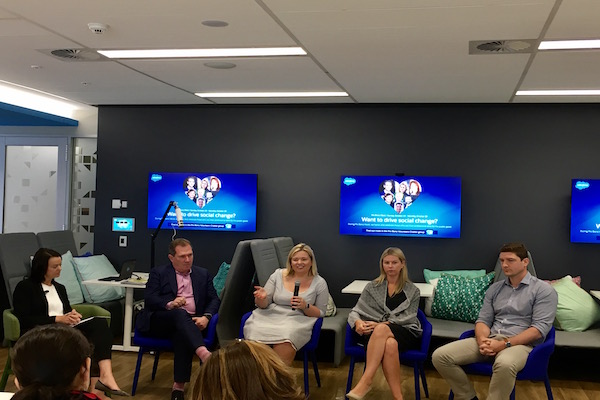
Get your FREE 30-day trial.
Start by selecting a product:
How do we encourage more women into technology professions? Do we research the gender issues? Do we map out and actually implement solutions? Or do we create action and inspiration at a grassroots level by telling our own stories?
At Salesforce, we do all three. Why? While we know there’s a business case for recruiting more women into tech companies, the reality is we work for equality because it’s the right thing to do. In our pursuit of gender equality, we need to cover all bases – research, implementation and grassroots change.
A recent Salesforce Women’s Network event was a great example of grassroots change. In partnership with NSW Government, we hosted a group of female STEM students from the University of Technology, Sydney as part of their study tour of leading technology companies. Salesforce was chosen as a leader in gender diversity and innovation, and as Australia’s best place to work (it’s not just us saying so!).
As part of the event, I hosted a panel session with two male and two female Salesforce staff members. There are a couple of reasons men were included in the panel, despite it being an event for female STEM students. Firstly, we knew the students would find shared experiences with one or more speakers regardless of whether they shared a gender. Secondly, as Elizabeth Broderick told us a few years ago, men play a vital role in achieving gender equality, so they are an integral part of our Women’s Network.

The panel – a great representation of gender equality – showed true diversity when it came to career progression. In sharing the stories of how they ended up where they are today, our speakers showed this group of bright women that, just as there is no single, ideal cardboard cut-out candidate for a tech career, there is more than one pathway to that career.
1. Make a plan
Salesforce’s SVP Commercial Sales APAC Eileen O’Mara said she always followed a career plan. Early on, after completing a Commerce degree, she focused on coding and moved up through the ranks at various companies in Europe, including Salesforce, before working in our region.
2. Follow your passion
Compare Eileen’s story to that of Rowena Westphalen, Director Solution Engineering, who worked as a programmer, looking after the mainframe of a major insurance company in South Africa. Rowena had been encouraged into programming by her grandfather when she was just 10 years old.
“I was the opposite to Eileen. I didn’t have a plan at all.”
All she knew was that she was passionate about the technology world that her grandfather had introduced to her. Rowena worked in the UK and Japan for several years before settling in Australia.
3. Focus on the big picture
Barry Dietrich is now our Regional Vice President, but at the age of 20 he was in the South African Army. Long periods in the bush gave him time to reflect on the career he wanted to pursue.
“I had a background in marketing but wanted to get into IT. That became my focus,” he said. “I wanted to get to a place where I felt I was making a difference. At Salesforce I feel like we are making a difference locally and globally. Importantly, when planning my career I learned not to get bogged down in the detail. I didn’t see myself living in Australia, for instance, but I knew on a bigger scale what I wanted to achieve.”
4. Find a role that fits your life
Alex Peattie, Principal Solution Engineer, said he never had a clear idea about the career he wanted, although he knew he wanted to travel with work. A computer science degree led to a graduate position with a major tech company which, after just a few years, took him to the USA for eight months and to London for several years.
These four tech professionals’ stories shared one inclusive theme: ambition and the drive to achieve a goal – no matter what inspires it. And, importantly, the idea that different people find different ways to get where they want to go.
They shared important lessons about the challenges they faced, the risks they took, the vital importance of mentors for fast-tracking your career and the more recent, social media-driven phenomenon of ‘personal brand’. We hope our panelists inspired the STEM students and showed them that anything is possible if you put your heart and mind to it.
I truly believe that for greater diversity in STEM professions to be achieved, and for the massive benefits that come from that diversity to be realised, stories need to be told. We can talk as much as we like about the lack of women in tech, but until success stories are told at a grassroots level, little will change.
Given the resounding success of our Salesforce Women’s Network event, I’m betting (and hoping) we’ll see some of those students’ faces again.
If you haven’t noticed yet, we value our company culture pretty highly here at Salesforce. Find out more about how we work for equality, and gain ideas for improving the culture of your workplace, by completing the Salesforce Ohana Culture Trailhead.
To receive regular content and updates about the work we are doing to help achieve equality in the technology industry, subscribe to our blog today.